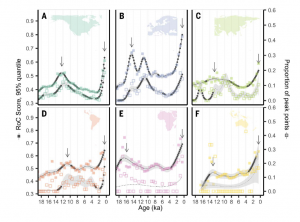We are developing a new set of molecular techniques to unlock secrets about past climates and ecosystems through the chemical analysis of fossil pollen. We aim to use these techniques tackle research challenges related to palaeoecology, biogeography and global change ecology, and to better understand how and why ecosystems and biodiversity change through time.
1. Developing a new proxy for UV-B radiation using pollen chemistry
Solar UV-B radiation is an important variable for understanding biosphere and climate dynamics in the past but no standardised method currently exists for reconstructing changes in UV-B irradiance in the geological record. Plants can respond chemically to UV-B exposure by increasing the abundance of UV-B absorbing compounds within their pollen-grain outer walls (exines). Because pollen is preserved in lake sediments, analysis of the chemical changes in pollen may reveal insights into long-term variations in UV-B over thousands of years. We are taking a systematic approach to develop a novel method for reconstructing UV-B using fossil pollen. We integrate field-based and experimental approaches to determine the chemical response of pollen grains to UV-B radiation. We then use this model to generate UV-B reconstructions based on the pollen chemistry variation found in fossil records across a range of timescales (decades to millennia). This research is currently funded by the Norwegian Research Council’s QUEST-UV project, and a Marie-Curie Fellowship (Natasha Barbolini).

Seddon, A.W.R., Festi, D., Nieuwkerk, M., Gya, R., Krüger, L.C., Östman, S.A.H., Robson, T.M. (2021). Pollen-chemistry variations along elevation gradients and their implications for a proxy for UV-B radiation in the plant-fossil record. Journal of Ecology DOI: 10.1111/1365-2745.13720
Seddon, A.W.R., Festi, D., Robson, T.M. and Zimmermann, B. (2019) Fossil pollen and spores as a tool for reconstructing ancient solar-ultraviolet irradiance received by plants: an assessment of prospects and challenges using proxy-system modelling. Photochemical and Photobiological Sciences DOI: 10.1039/C8PP00490K
2. Using pollen chemistry as a tool for taxonomic identification in palaeoecology
The fossil pollen remains preserved in lake sediments or peat bogs have been important tools to reconstruct past vegetation and environmental changes for over one hundred years. The basis of any fossil pollen reconstruction is the reliable identification of fossil pollen to the lowest taxonomic level possible. However, although Quaternary botany has been dominated for over one hundred years by pollen analysis, identifications can only be made to the genus or family level for many taxa. This is limiting the information gained from fossil pollen to relatively coarse taxonomic levels. One potential approach lies in the chemical analysis of fossil pollen, since the chemical compoisiton of pollen grains may vary according to phylogenetic signatures. We are using a variety of chemical techniques to investigate whether chemical variations in pollen can improve the current available information, and to apply these methods to a series of biogeographic and ecological applications. See a blog post by PhD student Florian Muthreich here.
Muthreich, F., Zimmermann, B., Birks, H.J.B., Vila-Viçosa, C.M. and Seddon, A.W.R. (2020) Chemical variations in Quercus pollen as a tool for taxonomic identification: implications for long-term ecological and biogeographic research. Journal of Biogeography http://dx.doi.org/10.1101/761148.
3. Global change ecology, biodiversity dynamics and the Anthropocene
Long-term ecological data is a vital tool for understanding current and future biodiversity and ecosystem dynamics in context. Sediments act like natural dataloggers, and are the only way that empirical information about ecosystem dynamics on timescales beyond standard ecological research timescales (1-10 years). We are interested in how long-term ecological information can be used to test and support ecological and biogeographic theory, and to improve understanding of biodiversity dynamics in the past and in the Anthropocene. We use a combination of molecular, tradiational palaeoecological and multiproxy datasets, combining information from across temporal scales to understand the patterns and drivers of biodiversity dynamics through time. We have close links to a PAGES working group focusing on quantifying and measuring Ecological Resilience and Regime Shifts in Palaeoecological Records, and in the ERC funded HOPE project, which is identifying the ecological effects of human impacts in the Anthropocene.

Mottl, O., Flantua, S.G.A., Bhatta, K.P., Felde, V.A., Giesecke, T., Goring, S., Grimm, E.C., Haberle, S., Hooghiemstra, H., Ivory, S., Kuneš, P., Wolters, S., Seddon, A.W.R., Williams, J.W. (2021) Global acceleration in rates of vegetation change over the last 18,000 years. Science. 372 (6544): 860-864
Seddon, A.W.R. Special feature: measuring components of ecological resilience in long-term ecological datasets, 2021. Biology Letters 17: 20200881. https://doi.org/10.1098/rsbl.2020.0881
Seddon, A.W.R., Macias Fauria, M., Long, P., Benz, D. and Willis, K.J. (2016). Sensitivity of global terrestrial ecosystems to climate variability. Nature 531: 229-231
